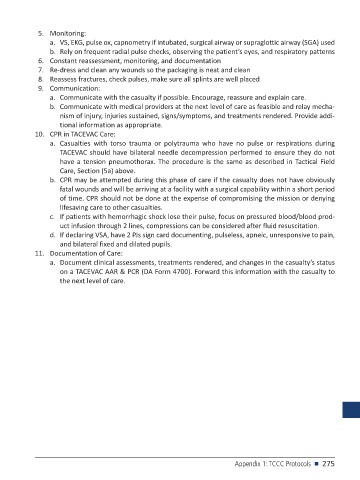Page 277 - PJ MED OPS Handbook 8th Ed
P. 277
5. Monitoring:
a. VS, EKG, pulse ox, capnometry if intubated, surgical airway or supraglottic airway (SGA) used
b. Rely on frequent radial pulse checks, observing the patient’s eyes, and respiratory patterns
6. Constant reassessment, monitoring, and documentation
7. Re-dress and clean any wounds so the packaging is neat and clean
8. Reassess fractures, check pulses, make sure all splints are well placed
9. Communication:
a. Communicate with the casualty if possible. Encourage, reassure and explain care.
b. Communicate with medical providers at the next level of care as feasible and relay mecha-
nism of injury, injuries sustained, signs/symptoms, and treatments rendered. Provide addi-
tional information as appropriate.
10. CPR in TACEVAC Care:
a. Casualties with torso trauma or polytrauma who have no pulse or respirations during
TACEVAC should have bilateral needle decompression performed to ensure they do not
have a tension pneumothorax. The procedure is the same as described in Tactical Field
Care, Section (5a) above.
b. CPR may be attempted during this phase of care if the casualty does not have obviously
fatal wounds and will be arriving at a facility with a surgical capability within a short period
of time. CPR should not be done at the expense of compromising the mission or denying
lifesaving care to other casualties.
c. If patients with hemorrhagic shock lose their pulse, focus on pressured blood/blood prod-
uct infusion through 2 lines, compressions can be considered after fluid resuscitation.
d. If declaring VSA, have 2 PJs sign card documenting, pulseless, apneic, unresponsive to pain,
and bilateral fixed and dilated pupils.
11. Documentation of Care:
a. Document clinical assessments, treatments rendered, and changes in the casualty’s status
on a TACEVAC AAR & PCR (DA Form 4700). Forward this information with the casualty to
the next level of care.
Appendix 1: TCCC Protocols n 275

